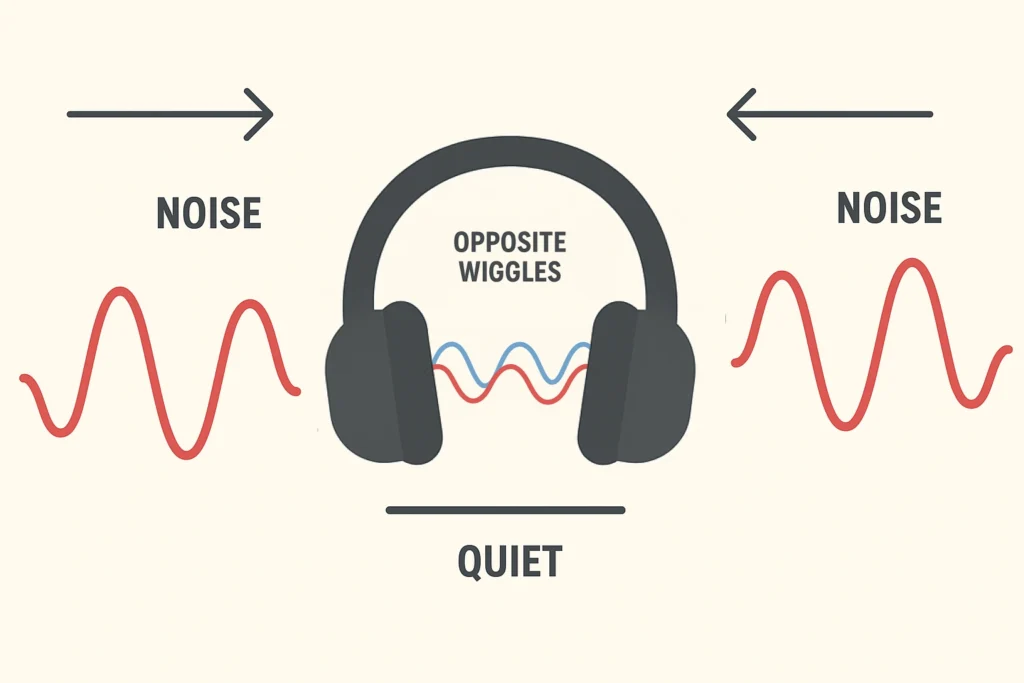If you’ve ever slipped on a pair of “magic” headphones and felt the chaos of the world fade away, you’ve experienced Active Noise Cancellation, or ANC for short. But what’s really going on inside those ear cups? Let’s start at the very beginning.
The Invisible Wiggles in the Air
Sound is just vibration moving through something, usually air.
When a guitar string vibrates, it pushes the air around it, creating little waves. Those waves travel outward until they hit your ears. Your brain turns them into the music, voices, or background racket you hear.
Two quick things to understand before we move on:
The size of those waves decides how loud the sound feels, and the speed of the waves controls the pitch; fast waves are high-pitched, slow ones are low. And without air, water, or some other medium, there’s nothing for the waves to travel through… which is why space is completely silent.
When Sound Turns Into Noise
Not all sound is welcome. The hum of a bus engine, the roar of a plane, or endless office chatter can drown out your focus. That’s noise, sound you don’t want. Too much of it can be tiring and overwhelming, especially if you’re sensitive to your surroundings.
And that’s exactly the problem noise-canceling headphones are built to solve.
Two Ways to Fight Noise
The first way is passive noise cancellation. That’s basically a fancy way of saying “block the sound before it gets to you.” Thick padding and ear cup design physically block part of the noise, like wearing cushioned ear muffs.
The second way, the one people get excited about, is active noise cancellation. Instead of blocking the noise, it erases it. The headphones actually listen to what’s happening around you and then create an “opposite” sound wave to cancel it out.
The Trick: Erasing Sound With Its Opposite
Here’s the fun part. If a wave of sound is like a +2, and you add a -2, the two cancel out to zero. Physics calls this “destructive interference.”

ANC headphones use this principle in real time. Tiny microphones on the outside pick up background noise. A small processor inside works out the opposite wave. Then the speakers play that opposite wave at the same time as the noise, wiping it out before it reaches your ears.
Some models go further. They put extra microphones inside the ear cups to double-check what you’re actually hearing, then fine-tune the cancellation on the spot. The high-end ones can even adjust automatically, going stronger in a noisy street and easing up in a quiet room.
Why People Love ANC
In a noisy place, ANC can bring down overall sound levels by about 30 decibels, and cut steady, low-pitched hums by as much as 60 decibels. That makes travel, work, or just relaxing way easier. It also means you can keep your music or podcasts at a lower, safer volume because you’re not trying to overpower the noise around you.
It’s not flawless, sudden sharp sounds like barking or clapping are harder to cancel, and some people notice a slight ear pressure or faint hiss when ANC is on. Plus, you need a good fit and charged battery for it to work well. But when it clicks, it feels like stepping into your own personal quiet zone.
Getting Used to the Quiet
If you’ve never used ANC before, it can feel strange at first. Try wearing them in short bursts until your ears and brain get used to that sudden calm.
Active Noise Cancellation isn’t magic, but it comes pretty close. By creating sound waves that are the mirror opposite of unwanted noise, it gives you the rare ability to control your soundscape, keeping the good, losing the bad.









